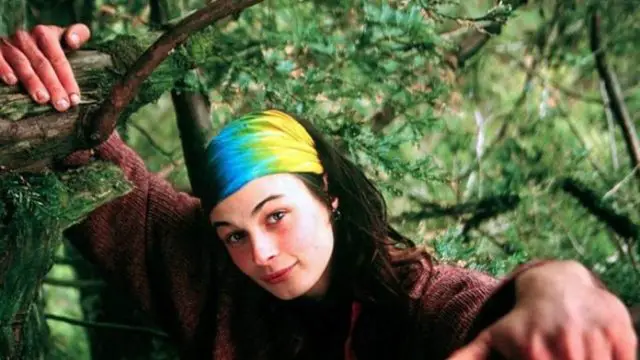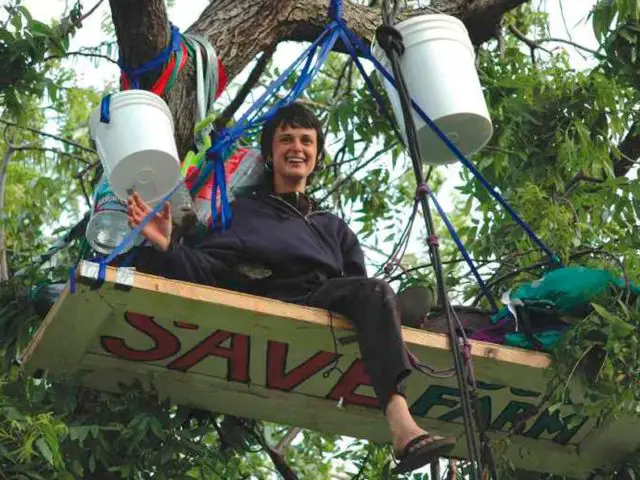
What would you do to prevent a majestic 1,500-year-old tree from falling victim to a logging saw? Would you risk your life, inhabiting a space in the heights no bigger than a single bed, in the open, going cold, hungry, pain, and isolation? How long would it last?
Well, Julia “Butterfly” Hill, an environmental activist, lived on top of a thousand-year-old redwood tree in Northern California for 738 days to prevent it from being cut down. She only agreed to put an end to her incredible protest and come down from the tree after winning her battle to protect it, as well as the area around it.
Several activists have occupied trees, but Julia’s protest is believed to have lasted the longest. “I think whoever wants to cut down one of these trees should be ordered to live in it for two years,” she declared about her feat.
“Beautiful and sacred”
Redwoods are monumental trees, native to California, United States.They can grow up to 75 meters in height, have trunks nine meters in diameter, and live for thousands of years.
“When I first came to California and entered the first ancestral forest, I was very touched and shocked by how beautiful and sacred they are and feel,” Julia said. Unfortunately, since the colonization of the Californian territory by western cultures, the continuous logging of this natural resource decimated the forests.
“At the beginning of my activism, I became aware that 97% of the forests of these ancient redwoods have already been destroyed,” she explained. In California a form of protest began in the late 1970s known as “tree sitting“, living in them to protect their logging. Julia Hill, who was nicknamed “Butterfly” at age seven, had been living with environmental activists in Humboldt County, Northern California.
The group was up against a logging company that was cutting down the region’s redwoods. They needed someone to occupy a tree to bring attention to the cause. Julia volunteered, thinking that she would only have to be up in the tree for about two weeks, maybe a month.
On December 10, 1997, she climbed the 55-meter-tall tree to giving it the name “Luna“. That was when it was realized what she had gotten herself into. “You are tied to a climbing rope; you use your hands and feet to slowly climb the tree. At about 25 meters high, I made the mistake of looking down. I panicked and froze. When I opened my eyes again, I kept my eyes fixed on Luna as I went up.”
However, the surroundings also had pleasant surprises in store for her. “The smell in the forest is extraordinary. The air is so sweet that you can taste it,” she described. Julia’s home in the tree was a platform eight feet by one and a half. About the size of a single bed.
After spending a year on it, she was able to assemble a second platform. Protected under a plastic tarp, her bed was reduced to a sleeping bag and her food was brought up with a rope.
During that time there was human contact, giving interviews to the media through a phone that worked with solar energy. But when it came time to face the bad weather, she was completely alone.
“It was very humid and cold. Even with the plastic canvas that served as my roof and walls, even the fog penetrated and the rain found small holes through which to drip from the branches onto the platform,” she said.
Withstanding storms with winds of up to 150 kilometers per hour, freezing rain, hail, and finally snow that destroyed her shelter, leaving her completely exposed to the elements. The weather conditions were so intense that she suffered severe frostbite because it did not dry out or heat up for weeks.
“Enduring the worst winter recorded in history at 18 stories high, on a small platform in the sky, challenged me in every way. My desire to feel warm and dry, the fear of dying. It brought me to the brink of all possible fears that I had. And it was through that experience that I evolved as a human being,” she said.
Opposition, doubts and new breath

But not everyone was equally impressed. Because she was carrying out an act of civil disobedience – being on territory that someone claimed belonged to him – earning her the displeasure of the logging company.
But she was determined to survive, although there were some people with equal determination to force her down. “They tried various ways to force me down: from cutting off my supplies and food, leaving me hungry, to honking loud horns throughout the night and day, for many days, so I couldn’t sleep.”
There were moments of doubt when she almost gave up
“I am a human being. There were times when I said ‘I can’t take it anymore.’ Moments when I curled up in the fetal position to cry, ‘I can’t take it anymore, not a minute more,'” she confessed, but something always happened that gave her new breath.
“Whether it was a response from nature, or someone arriving unexpectedly with some kind of gift, or a bear passing through the forest eating berries – it’s amazing to see an animal this big -. There were little incidents like that, at times when I couldn’t stand it anymore, something was happening that told me you must hold on. One more breathes, one more moment.”
Over time some things in tree life became easier, others more difficult. “After the storms, I would collect branches and weave them from the torn pieces of canvas and my roof became something like a basket of branches, plastic, and duct tape.”
Constantly having to rebuild her shelter because bad weather took it down from time to time. Persisting. “I did not go down because I had given my word that I would not do it before doing everything I could,” she said.
Victory
Julia’s impressive two-year protest attracted attention throughout the United States and beyond. They dedicated several songs to her. On December 18, 1999, Julia’s protest finally ended. An agreement had been reached with the logging company.
Julia and the other activists had managed to raise the US $ 50,000 and effectively paid the logging company to rescue the tree and a surrounding area of about 12,000 square meters. The cameras captured the dramatic moment when the environmental advocate descended in tears.
“It was an extraordinary feeling when I first touched the ground. People thought that I had fallen to the ground because my muscles weren’t strong enough. But actually, I fell to the ground because the emotions, the energy, and all the sensations were so deep. I couldn’t stand up.”
Continuous activism
Julia “Butterfly” Hill is convinced of the repercussions of her action in the protection of one of the natural treasures of California and the World. “Since nothing happens in a vacuum, it is scientifically impossible not to have an impact,” she stated.
A year after Julia came down from Luna; the sequoia was attacked by a vandal, who cut the trunk 80cm deep with a saw. After a delicate intervention by specialists who managed to stabilize the tree, it is still standing, as well as the others around it. And Julia is left with the unique experience of having lived in it for almost two years.
“There were so many deep and beautiful moments,” she remembers. “One of them was when the fog covered the valley completely. I woke up early in the morning and saw that nothing else was above the fog and as the sun rose the fog turned into a lagoon of gold, pink, orange, very light blue. A rainbow lagoon.”
However, her activism did not end with that impactful experience. Julia “Butterfly” Hill co-founded the Circle of Life Foundation, which advocates for the transformation of human interactions with nature. From her experience occupying trees, she wrote the book “The legacy of Luna: the story of a tree, a woman and the fight to save the redwoods.”
In 2002, Hill was deported from Ecuador, where she had participated in a protest against the Occidental Oil Company plans to build a pipeline that would cross indigenous territories. Her work in defense of the environment and small farmers continues, giving talks, participating in symposiums, and giving eco-workshops.


